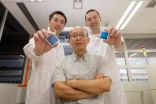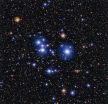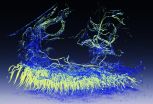Not just for the holidays, mistletoe could fight obesity-related liver disease
2014-12-17
(Press-News.org) Mistletoe hanging in doorways announces that the holidays are just around the corner. For some people, however, the symbolic plant might one day represent more than a kiss at Christmas time: It may mean better liver health. Researchers have found that a compound produced by a particular variety of the plant can help fight obesity-related liver disease in mice. Their study appears in ACS' Journal of Agricultural and Food Chemistry.
Jungkee Kwon and colleagues note that, according to recent research, Korean mistletoe produces a number of biologically active compounds. These include familiar ones such as steroids and flavonoids. Also, extracts from the plant have shown anti-obesity effects, but no one had confirmed which specific molecules were involved. Kwon's team wanted to investigate the matter and see if the key ingredient could also help fight fatty liver disease, which is associated with obesity and can progress to liver failure in some cases.
The researchers identified viscothionin as the compound in Korean mistletoe that affects fat metabolism in the liver. When they treated obese mice with it, their body and liver weights dropped. The scientists conclude that viscothionin could be explored as a potential therapeutic agent for the treatment of nonalcoholic fatty liver disease.
INFORMATION:
The authors acknowledge funding from the National Research Foundation of Korea and the Korea Science and Engineering Foundation.
The American Chemical Society is a nonprofit organization chartered by the U.S. Congress. With more than 161,000 members, ACS is the world's largest scientific society and a global leader in providing access to chemistry-related research through its multiple databases, peer-reviewed journals and scientific conferences. Its main offices are in Washington, D.C., and Columbus, Ohio.
To automatically receive news releases from the American Chemical Society, contact newsroom@acs.org.
Follow us: Twitter Facebook
ELSE PRESS RELEASES FROM THIS DATE:
2014-12-17
Social media such as Twitter and Facebook can be valuable in the fight against HIV in the United States, where research has demonstrated they can prompt high-risk populations to request at-home testing kits for the virus that causes AIDS, suggesting a way to potentially boost testing rates.
But does it lead to actual testing, and can it work outside the United States? A new study from the UCLA Center for Digital Behavior published online Dec. 15 by the peer-reviewed journal Lancet HIV suggests that it can. The study, conducted in Peru among men who have sex with men, ...
2014-12-17
MAYWOOD, Ill. - Although stroke is the No. 4 cause of death and a leading cause of disability in the United States, there's an increasing shortage of neurologists who specialize in stroke care.
In the December issue of the journal Stroke, two prominent neurologists propose a bold program to increase the number of stroke specialists. Their proposals include encouraging more young physicians to specialize in stroke, increasing stroke specialists' pay and opening the subspecialty to physicians who are not neurologists.
The authors are Harold P. Adams, Jr., MD of the University ...
2014-12-17
(SACRAMENTO, Calif.) -- While the overall death rate from firearm violence has remained unchanged for more than a decade, the patterns for suicide and homicide have changed dramatically, a UC Davis study on the epidemiology of gun violence from 2003 to 2012 has found. The study posted online in the Annual Review of Public Health on Dec. 12 and will appear in the print edition in January.
"Suicide by firearm is far more common than homicide," said Garen J. Wintemute, professor of emergency medicine and director of the Violence Prevention Research Program at UC Davis. ...
2014-12-17
Recent research at Griffith University has found that personality is more important than intelligence when it comes to success in education.
Dr Arthur Poropat from Griffith's School of Applied Psychology has conducted the largest ever reviews of personality and academic performance. He based these reviews on the fundamental personality factors (Conscientiousness, Openness, Agreeableness, Emotional Stability, and Extraversion) and found Conscientiousness and Openness have the biggest influence on academic success.
The results have been published in the journal Learning ...
2014-12-17
Nanyang Technological University (NTU Singapore) scientists have developed a smart window which can darken or brighten without the need for an external power source.
This unique self-tinting window requires zero electricity to operate and is also a rechargeable battery. The window's stored energy can be used for other purposes, such as to light up low-powered electronics like a light emitting diode (LED).
Currently, the window solutions in the market are either using permanent tinting which cannot brighten at night or are windows that can change its light transmission ...
2014-12-17
A team of biologists has identified a set of nerve cells in desert locusts that bring about 'gang-like' gregarious behaviour when they are forced into a crowd.
Dr Swidbert Ott from the University of Leicester's Department of Biology, working with Dr Steve Rogers at the University of Sydney, Australia, has published a study that reveals how newly identified nerve cells in locusts produce the neurochemical serotonin to initiate changes in their behaviour and lifestyle.
The findings demonstrate the importance of individual history for understanding how brain chemicals ...
2014-12-17
Messier 47 is located approximately 1600 light-years from Earth, in the constellation of Puppis (the poop deck of the mythological ship Argo). It was first noticed some time before 1654 by Italian astronomer Giovanni Battista Hodierna and was later independently discovered by Charles Messier himself, who apparently had no knowledge of Hodierna's earlier observation.
Although it is bright and easy to see, Messier 47 is one of the least densely populated open clusters. Only around 50 stars are visible in a region about 12 light-years across, compared to other similar objects ...
2014-12-17
Treating bacterial infections with antibiotics is becoming increasingly difficult as bacteria develop resistance not only to the antibiotics being used against them, but also to ones they have never encountered before. By analyzing genetic and phenotypic changes in antibiotic-resistant strains of E. coli, researchers at the RIKEN Quantitative Biology Center (QBiC) in Japan have revealed a common set of features that appear to be responsible for the development of resistance to several types of antibiotics.
The study published in Nature Communications shows that resistance ...
2014-12-17
Fireflies used rapid light flashes to communicate. This "bioluminescence" is an intriguing phenomenon that has many potential applications, from drug testing and monitoring water contamination, and even lighting up streets using glow-in-dark trees and plants. Fireflies emit light when a compound called luciferin breaks down. We know that this reaction needs oxygen, but what we don't know is how fireflies actually supply oxygen to their light-emitting cells. Using state-of-the-art imaging techniques, scientists from Switzerland and Taiwan have determined how fireflies control ...
2014-12-17
This news release is available in French. This news release is available in French.
People with a severe mental disorder who commit a crime and who are incarcerated have different characteristics compared to people who are hospitalized after committing an offence. These are the findings of a study by researchers at the Institut universitaire en santé mentale de Montréal (IUSMM) and the Institut Philippe-Pinel de Montréal (IPPM), affiliated with the University of Montreal.
"We found a clear difference between people with a mental illness who are ...
LAST 30 PRESS RELEASES:
[Press-News.org] Not just for the holidays, mistletoe could fight obesity-related liver disease



